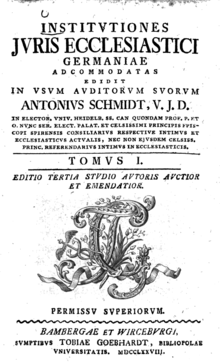Philipp Anton Schmidt
Philipp Anton Schmidt (born May 13, 1734 in Arnstein (Lower Franconia) ; † September 13, 1805 in Bruchsal ) was a Jesuit and auxiliary bishop in Speyer and titular bishop of Thermae Basilicae .
Live and act
Philipp Anton Schmidt came from the Lower Franconian town of Arnstein, where his father was the chief customs officer in the service of the Prince-Bishop of Würzburg . He was one of four sons in the civil servant family, all of whom became clergy; his youngest brother was the priest historian Michael Ignaz Schmidt (1736–1794).
The young man stepped in 1751 to Mainz in the Jesuit order one, taught from 1754 to 1759 at the Jesuit College Bamberg the humanities , studied at Bamberg University theology and canon law and a doctorate in both subjects. On September 18, 1762 he was ordained a priest .
Schmidt then worked from 1769 to 1778 as a professor of canon law at Heidelberg University ; In 1770 he also received his doctorate in secular law. He kept his chair after the dissolution of the Jesuit order in 1773 and became a secular priest . For this purpose he was formally incardinated in the diocese of Speyer in 1775 . In Heidelberg he wrote numerous writings against the national church and enlightenment Febronianism . This made the Speyer prince-bishop Damian August von Limburg-Stirum aware of him, who represented the same positions. He drew him as Regens to the Speyer seminary in Bruchsal , where he taught canonical and civil law. In 1777 Schmidt received a canonical at the All Saints' Foundation in Speyer , and later also a benefice at the Bruchsal Church of Our Lady . In 1780 he became Privy Councilor and Vicariate Director of the Principality, leading the country's secular government.
When the Speyer Auxiliary Bishop Johann Andreas Seelmann died in 1789, Philipp Anton Schmidt took his place. On March 29, 1790 he was appointed titular bishop of Thermae Basilicae and auxiliary bishop in the Prince Diocese of Speyer. The episcopal ordination gave him Prince Bishop Damian August von Limburg-Stirum on May 16 of that year in person.
Schmidt had already written the famous polemic against the Emser punctuation for his sovereign in 1787 and Franz Xaver Remling describes him as the “right arm” of Limburg-Stirum in all theological matters. When the French revolutionary troops moved in in 1795, Auxiliary Bishop Schmidt rushed to flee, which earned him a reprimand from his episcopal master.
Damian August von Limburg-Stirum died in 1797. Philipp Franz Wilderich Nepomuk von Walderdorf succeeded him as the last Prince-Bishop of Speyer. Philipp Anton Schmidt continued to hold his offices under him, even though he was already ailing. Following the Concordat of 1801 between Pope Pius VII and Napoleon , the French occupation of the German territories to the left of the Rhine established congruent dioceses at the departmental seats. The old German dioceses were declared dissolved with regard to their left bank, now French. Politically, most of the areas on the left bank of the Rhine of the Principality of Speyer fell to the new French Département du Mont-Tonnerre with the capital Mainz , and from a religious point of view to the congruent, new Grand Diocese of Mainz . A smaller part fell to the Bas-Rhin department and the congruent diocese of Strasbourg .
On the right bank of the Rhine, the prince-bishopric of Speyer continued to exist politically and religiously until the Reichsdeputationshauptschluss of 1803, after that only as a spiritual body. Philipp Anton Schmidt died in 1805 as the last auxiliary bishop of the old prince-bishopric in Bruchsal and was buried on September 15, 1805 in the local cemetery near St. Peter . In 1810, Prince-Bishop von Walderdorf also died, in 1821 the remaining Speyer area on the right bank of the Rhine fell to the new Archdiocese of Freiburg as the "Vicariate Bruchsal" . On the left bank of the Rhine, the new - now purely Bavarian - diocese of Speyer was established.
Ecclesiastical significance
According to Otto B. Roegele , the same applies to Philipp Anton Schmidt - due to his authorship of the Speyer pamphlet against the Emser puncture - what Johannes Rößler wrote about Prince-Bishop August Damian Limburg-Stirum in the communications of the Historical Association of the Palatinate (born 1915) had: “By standing up he preserved the Pope's influence on the German Catholics and prevented the disruption of Catholicism in national churches. The quiet development of Roman Catholicism in Germany is his work. ” Philipp Anton Schmidt was one of the most famous canonists of his time.
literature
- Johannes Madey : Philipp Anton Schmidt. In: Biographisch-Bibliographisches Kirchenlexikon (BBKL). Volume 9, Bautz, Herzberg 1995, ISBN 3-88309-058-1 , Sp. 476.
- Franz Xaver Remling : History of the bishops of Speyer . Volume 2, Verlag Kirchheim, Mainz 1854, p. 718 ff. ( Digitized version )
- Johann Friedrich von Schulte: Schmidt, Philipp Anton . In: Allgemeine Deutsche Biographie (ADB). Volume 32, Duncker & Humblot, Leipzig 1891, p. 12 f.
Web links
Individual evidence
- ↑ Source on family relationships, from a biography about Michael Ignaz Schmidt
- ↑ Source on the complaint by Prince-Bishop Limburg-Stirum
- ^ Source on Illness
- ↑ To the Peterskirche Bruchsal
- ↑ Otto B. Roegele: The seminary at Bruchsal (1724-1804) . In: Alfons Kloos (Hrsg.): St. German in the city and diocese of Speyer. A contribution to the history of the Episcopal Seminary in Speyer . Diocese Speyer, Speyer 1957, pp. 110-139, quotation pp. 122-123.
- ↑ Appreciation as a famous canonist, 1829
- ↑ Appreciation of Auxiliary Bishop Schmidt as a canon lawyer
| personal data | |
|---|---|
| SURNAME | Schmidt, Philipp Anton |
| BRIEF DESCRIPTION | Auxiliary Bishop in Speyer |
| DATE OF BIRTH | May 13, 1734 |
| PLACE OF BIRTH | Arnstein (Lower Franconia) |
| DATE OF DEATH | September 13, 1805 |
| Place of death | Bruchsal |


